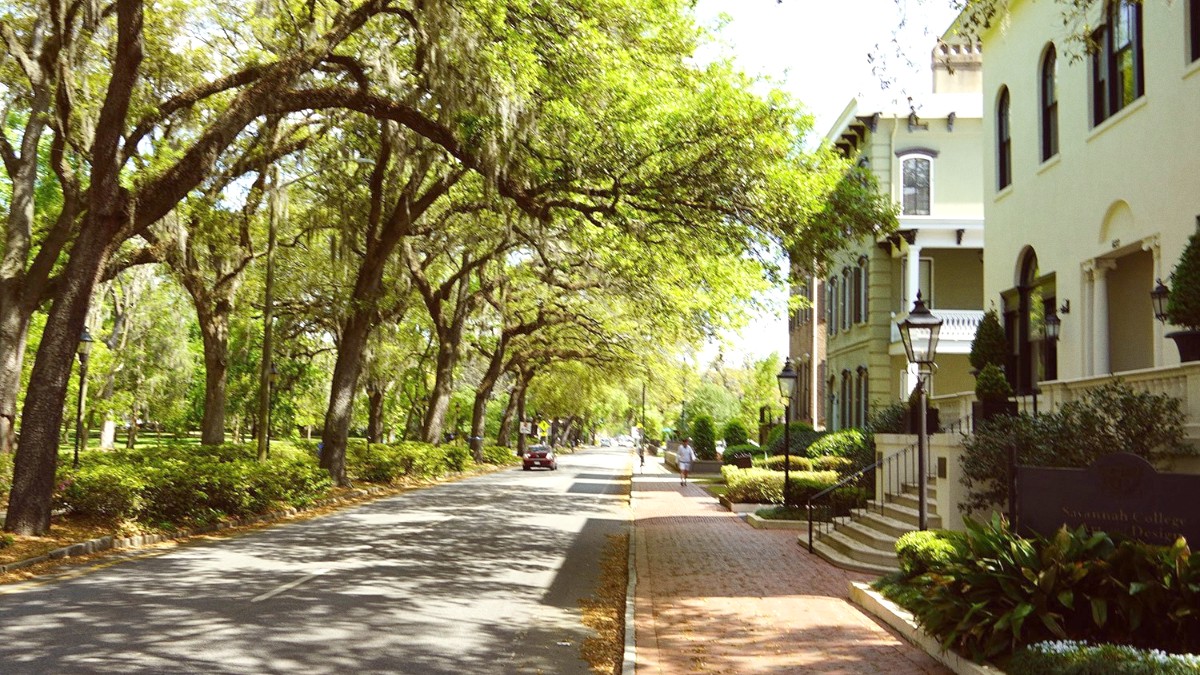
Georgia, USA
Discover a place where every square carries a past, every street whispers tales, and hospitality is a way of life.
Savannah’s commitment to preserving its past is evident in its meticulously maintained historic buildings and tree-lined public spaces.
The city caters to a wide range of interests, from historical enthusiasts and architecture lovers to those seeking unique culinary experiences or paranormal investigations.
The Savannah River, a major waterway in the southeastern United States, defines the city's northern boundary and acts as a conduit to the sea. Its deep channel accommodates large cargo ships to access the Port of Savannah. The river also features recreational opportunities, including riverboat tours that deliver different views of the city skyline and industrial waterfront. The river's tidal nature shapes its flow and the nearby marsh ecosystems.
Savannah's proximity to the Atlantic Ocean brings specific environmental conditions. The city has a humid subtropical climate, characterized by warm, humid summers and mild winters. These low-lying areas, including the expansive salt marshes bordering the city, form the local ecosystem.
Savannah’s location makes it a gateway to Georgia's barrier islands, including Tybee Island, a short drive to the east. Tybee Island offers sandy beaches and a relaxed coastal atmosphere.
For a different perspective of Savannah, consider a riverboat cruise on the Savannah River. These tours present views of the port operations and the city’s historic waterfront.
The city's relatively flat landscape makes walking and cycling enjoyable ways to explore the Historic District, though specific areas can have uneven cobblestone streets.
The deep channel of the Savannah River accommodates large cargo ships, linking the Port of Savannah to the sea.
Expansive salt marshes bordering the city comprise integral parts of the local ecosystem, home to diverse bird and marine life.
Savannah occupies a place in American history as the first colonial capital of the Province of Georgia. James Oglethorpe founded the city in 1733, setting a vision for a planned community built around a series of public squares. This innovative urban layout, with its grid pattern and open green spaces, served to prevent urban sprawl and aid community gathering. Today, 22 of these original squares remain, serving as charming parks and focal points throughout the Historic District.
The city had roles in both the American Revolution and the American Civil War. During the Revolutionary War, Savannah was a site of contention. The Siege of Savannah in 1779 represents a significant but unsuccessful attempt by American and French forces to retake the city from British control. Markers and monuments throughout the city commemorate this period. Perhaps more famous is Savannah’s experience during the American Civil War. Unlike many Southern cities that suffered extensive destruction, Savannah was largely spared during Union General William Tecumseh Sherman's "March to the Sea" in late 1864. Sherman's decision to preserve the city, offering it as a "Christmas gift" to President Lincoln, meant that Savannah's antebellum architecture and urban plan remained largely intact. This preservation lets visitors today experience a city that looks much as it did in the 19th century. The historic buildings, from grand mansions to more modest homes, showcase various architectural styles, including Federal, Georgian, and Victorian. Many are restored and now function as museums, bed and breakfasts, or private residences. Savannah's history also connects to its role as a major port for cotton export in the 19th century. The city's waterfront, specifically River Street, once hummed with the activity of the cotton trade. Warehouses that once stored bales of cotton now feature shops, restaurants, and galleries, giving a glimpse into this prosperous yet often harsh period. The city's wealth during this era funded the construction of many of the elegant homes and public buildings seen today. Beyond its military and economic history, Savannah also features rich cultural heritage. It functions as a center for Gullah Geechee culture, an unique culture formed by descendants of enslaved Africans who inhabited the Lowcountry region of Georgia and South Carolina. Their traditions affected the local cuisine, language, and arts. Irish immigration also shaped Savannah’s character; the city includes one of the largest St.
Savannah's antebellum architecture and urban plan remained largely intact after the Civil War, offering a preserved view into 19th-century America. Many historic buildings have been restored.
The city is a center for Gullah Geechee culture, with traditions that influenced local cuisine, language, and arts. Irish immigration significantly shaped Savannah’s character.
Savannah’s historic squares are not just beautiful, they embody Oglethorpe's original town planning. Spend time in different squares to notice their unique monuments, landscaping, and character.
Savannah, Georgia, stands recognized for its preserved 18th and 19th-century architecture, cobblestone streets, and 22 historic squares. This combination forms a distinct atmosphere that draws visitors from around the world.
The city's commitment to preserving its past is evident in its meticulously maintained historic buildings and tree-lined public spaces. Tourism represents a main industry in Savannah, catering to diverse interests.
The city's welcoming atmosphere and diverse attractions contribute to its reputation as "The Hostess City of the South," a title that echoes its deep-seated tradition of hospitality.
SCAD has transformed many historic buildings into academic spaces, galleries, and student housing, breathing new life into neglected areas. This artistic energy works with the city's historical foundations, establishing a dynamic cultural layer.
The Port of Savannah is a pillar of the local economy. It ranks as one of the largest and fastest-growing container ports in North America. This economic engine ensures Savannah's position not just as a relic of the past but a forward-looking city with a modern industrial presence.
Ghost tours are especially popular, given Savannah’s reputation as one of America's most haunted cities.
The port's activity supports a wide range of related businesses and provides many jobs, contributing to the city's ongoing economic vitality.